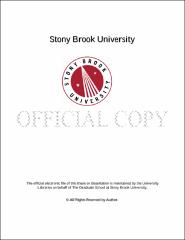| dc.identifier.uri | http://hdl.handle.net/11401/77019 | |
| dc.description.sponsorship | This work is sponsored by the Stony Brook University Graduate School in compliance with the requirements for completion of degree. | en_US |
| dc.format | Monograph | |
| dc.format.medium | Electronic Resource | en_US |
| dc.language.iso | en_US | |
| dc.publisher | The Graduate School, Stony Brook University: Stony Brook, NY. | |
| dc.type | Dissertation | |
| dcterms.abstract | The widespread use of portable electronics and growing interest in electric and hybrid vehicles has generated a mass market for batteries with increased energy densities and enhanced electrochemical performance. In order to address a variety of applications, commercially fabricated secondary lithium-ion batteries employ transition metal oxide based electrodes, the most prominent of which include lithium nickel manganese cobalt oxide (LiNixMnyCo1-x-yO2), lithium iron phosphate (LiFePO4), and lithium manganese oxide (LiMn2O4). Transition metal oxides are of particular interest as cathode materials due to their robust framework for lithium intercalation, potential for high energy density, and utilization of earth-abundant elements (i.e. iron and manganese) leading to decreased toxicity and cost-effective battery production on industrial scales. Specifically, this research focuses on MgFe2O4, AgxMn8O16, and AgFeO2 transition metal oxides for use as electrode materials in lithium-based batteries. The electrode materials are prepared via co-precipitation, reflux, and hydrothermal methods and characterized by several techniques (XRD, SEM, BET, TGA, DSC, XPS, Raman, etc.). The low-temperature syntheses allowed for precise manipulation of structural, compositional, and/or functional properties of MgFe2O4, AgxMn8O16, and AgFeO2 which have been shown to influence electrochemical behavior. In addition, advanced in-situ and ex-situ characterization techniques are employed to study the lithiation/de-lithiation process and establish valid redox mechanisms. With respect to both chemical and physical properties, the influence of MgFe2O4 particle size and morphology on electrochemical behavior was established using ex situ X-ray absorption spectroscopy (XAS) and transmission electron microscopy (TEM) imaging. Based on composition, tunneled AgxMn8O16 nanorods, prepared with distinct Ag+ contents and crystallite sizes, display dramatic dierences in ion-transport kinetics due to structural defects which facilitate Li+ diusion through the tunnel walls and intimate electrochemical connection of bundled nanorods. Finally, a one-pot synthesis provided a series of AgFeO2/gamma-Fe2O3 or AgxFeOy composites which, at the lowest silver regime (Ag0.2FeO1.6), exhibit 2X higher capacity than stoichiometric AgFeO2 and over 3X greater capacity than nanocrystalline gamma-Fe2O3 after 50 cycles. Notably, mechanical mixing of AgFeO2 and gamma-Fe2O3 powders to mimic a one-pot Ag0.2FeO1.6 composite yields lower delivered capacity and energy density where the results demonstrate the advantages of the directly prepared composite with more intimate particle connectivity not achievable through mechanical mixing. | |
| dcterms.available | 2017-09-20T16:51:40Z | |
| dcterms.contributor | Takeuchi, Esther S | en_US |
| dcterms.contributor | Takeuchi, Kenneth J | en_US |
| dcterms.contributor | Marschilok, Amy C | en_US |
| dcterms.contributor | Koch, Stephen A | en_US |
| dcterms.contributor | Wong, Stanislaus S | en_US |
| dcterms.contributor | Gan, Hong . | en_US |
| dcterms.creator | Durham, Jessica | |
| dcterms.dateAccepted | 2017-09-20T16:51:40Z | |
| dcterms.dateSubmitted | 2017-09-20T16:51:40Z | |
| dcterms.description | Department of Chemistry | en_US |
| dcterms.extent | 230 pg. | en_US |
| dcterms.format | Monograph | |
| dcterms.format | Application/PDF | en_US |
| dcterms.identifier | http://hdl.handle.net/11401/77019 | |
| dcterms.issued | 2016-12-01 | |
| dcterms.language | en_US | |
| dcterms.provenance | Made available in DSpace on 2017-09-20T16:51:40Z (GMT). No. of bitstreams: 1
Durham_grad.sunysb_0771E_13082.pdf: 17989931 bytes, checksum: 1213db82a8e3645eb20046c4b6cbe52c (MD5)
Previous issue date: 1 | en |
| dcterms.publisher | The Graduate School, Stony Brook University: Stony Brook, NY. | |
| dcterms.subject | Inorganic chemistry -- Materials Science -- Chemistry | |
| dcterms.subject | Battery, Electrode, Iron Oxide, Lithium, Manganese Oxide | |
| dcterms.title | Nanostructured Iron and Manganese Oxide Electrode Materials for Lithium Batteries: Influence of Chemical and Physical Properties on Electrochemistry | |
| dcterms.type | Dissertation | |


